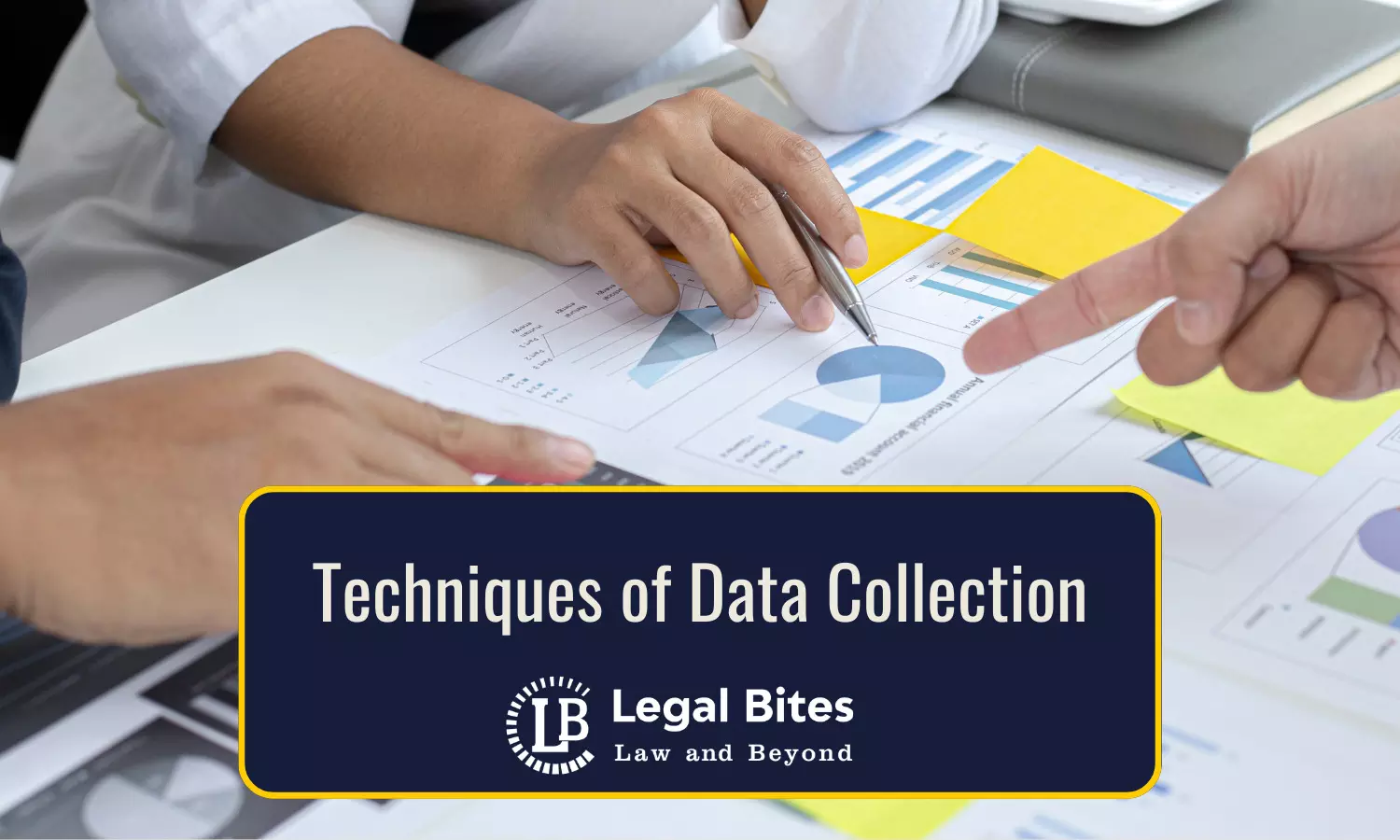Techniques of Data Collection | Research Methodology
This article outlines essential data collection techniques in research methodology, empowering readers with the knowledge needed to effectively analyze data.

This article outlines essential data collection techniques in research methodology, empowering readers with the knowledge needed to effectively gather and analyze data for their research projects.
Introduction
Legal research can be defined as finding any particular law and understanding how they have been interpreted and applied by courts through case law analysis. It involves books, case laws, journals and other sources. Research is the process of identifying and investigating a problem and analyzing it with a solution. The research methodology refers to the practicability of any piece of study. In other words, researchers systematically research and design a survey to ensure the validity and reliability of any research. A dissertation, thesis, or any academic journal covers the aspects of research methodology.
Types of Research
Doctrinal Research
The doctrinal research that deals with finding and developing legal doctrines and research for writing in textbooks and journals asking, "What is the law?" is normative. The nature of legal rules is normative because they tell us how to act as people. This is why it is sometimes called research in the area of law. Thus, this research has helped the Courts have valid arguments and reach a better judgment. It has focused on the objective of particular laws and helped to find loopholes in the existing rules and statutes.
Non-Doctrinal Research
This research involves a comprehensive approach towards the research. It involves primary sources, including surveys, questionnaires, observation, etc. With the help of these techniques, the researchers analyze the practicability of a relevant subject and implement it accordingly as a whole. The main focus is how the laws are enforced and work in the real world.
Thus, this research aims to check how the statutes have been utilized and how it has impacted society. It focuses on the law in action, which means analyzing the effect of the law on people and culture and how to bring different legal reforms to establish transformation in society.
Data Collection
In statistics, data collection means systematically collecting data that is relevant to the research question or problem being addressed. It's helpful to think about how the problem turned out. How the data was gathered, let someone conclude the answer to the question. Most companies use methods for gathering data to guess about chances and trends in the future.
Data organization often begins during the data collection phase, as researchers need to ensure that collected data is properly recorded, categorized, and stored for analysis. The most important thing about collecting data in a research study is that it helps you figure out various aspects related to a particular subject and how it will be effective in solving the issues. There are two ways to collect data in a research methodology i.e. Primary Source and Secondary Source.
Tools of Data Collection in Research
Primary Sources
When you do experiments, polls, or look around, you can get first-hand information called primary or raw data. In simple words, the data is collected from a direct source. It can be observed either through observation or from direct communication. After collecting the data, the researcher has to organize and analyze it to answer the research questions. The term analysis refers to calculating measures to find the pattern or relationship pattern amongst the existing groups. Primary data collection is the most reliable to provide better results.
The tools for primary data are as follows:
A. Observation Method
This technique records the behaviour. It is used to explore the subject area, find the problem, and provide a hypothesis.
B. Questionnaire Method
This method is the most suitable technique for socio-legal problems. The questionnaire has been collected with large groups from different places. They are the list of questions which has to be answered by different groups of people to know their views. The questions which are asked should be short and simple. It involves open-ended questions, multiple choice and leading questions.
C. Interview Method
This method involves the presentation of the individuals through personal interviews or it can be telephonic interviews. It requires person face to face contact, as well as the interviewer, has to collect information personally to know their views and opinions.
D. Case Study Method
The case study method is a popular technique. It involves careful observation and in-depth study of a social unit which involves a person, family, institution or community. It is a detailed study which is conducted to trace the history of the social unit.
Secondary Sources
These data are collected by some other source or based on statistical analysis. It is the compilation of existing information. They are obtained from different literature about relevant subjects. The sources are reports, journals, books, articles, etc. This data gives insights into the research and helps the researcher discover the gaps. These data can be collected from internal or external sources to cover a wide range of information. It has been divided into two methods:
A. Quantitative Data
This data focuses on measurement and testing the numerical data. It is used to measure the relationship between two variables. It is based on calculations done in several ways, such as with closed-ended questions, association and regression methods, and mean median, and mode measures. It takes less time and costs less money to use this method than qualitative data collection methods. The data was used in Excel, SPSS 2.0, Word, and other tools. The data are obtained through questionnaires. It identifies and assigns numeric values to data. The data are entered into a statistical analysis software package. After this, it analyses the relationship and compares groups using correlation, tabulations and other methods.
The advantages of quantitative data are as follows:
i. Reliability: It ensures consistent measurement across various variables. It checks the stability and consistency of the data. The researcher will check the accuracy through reliability analysis. Thus, the measurement will provide accurate results without any biases.
ii. Validity: The researcher ensures the study by developing various data collection methods for clarity and accuracy through different instruments.
B. Qualitative Data
These data focus on collecting, analyzing and textual data. It is used to understand the individual perceptions and views relating to relevant subjects. For this, there are no math formulas needed. This method has a lot to do with things that can't be measured. The tools are Books, journals, articles, judgments, parliament orders, legal websites and so on.
Conclusion
Law controls how people act, which could be called behavioural science. Laws must adapt to changes in society to stay relevant. Laws can remain relevant, helpful, and active as long as they know their flaws and work to fix them over time. So, legal research aims to find holes or problems in the current laws and offer ways to improve them.
For places where there is already a law but it doesn't work for some reason, the goal would be to tell that changes be made to the current law when studies are done as part of the process of changing the law. Research is an inquiry that aims to test a new theory or add to existing ideas by gathering further information. No research can be called entirely new because all information builds on what we already know. A researcher working on a project for work already knows a lot about it. As they research, they continue to learn more and then develop some hypotheses based on what they've learned. Learning new things by looking into current laws is an ongoing process.
The research technique shows how the whole research study will go. Different studies use the same data sources and ways of gathering data. The research projects and framework are offered throughout the research process, from solving the problem to ensuring accuracy. Researchers come up with and write down research methodologies, which help them think about how to collect data and the steps they need to take, from stating a problem to finding solutions. New researchers can learn how to approach the research environment of the study by following research methods.
References
[1] Bhavna Sharma, Fundamentals of Legal Research And Legal Research Methodology, Edition: 2020
[2] Dr. S.R. Myneni, Legal Education & Research Methodology, Edition: 2023
[3] J. Mahalakshmi and P. Balamurugan, Legal Research Methodology, Edition: 2023
[4] Manoj Kumar Sinha, Legal Research and Writing, Edition: 2023
[5] Tushar Kanti Saha, Textbook On Legal Methods, Legal Systems & Research, Edition: 2022

